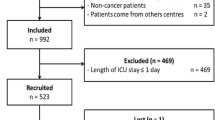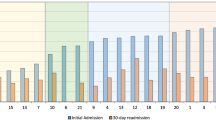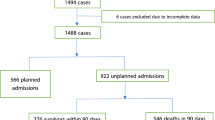Abstract
Purpose
The purpose of the study was to identify factors that predict unplanned admission for metastatic cancer patients visiting the emergency department (ED).
Methods
Patients visiting the ED of a general hospital from April 2012 to March 2013 were investigated retrospectively. Data including demographics, vital signs, and laboratory measurements were collected from a chart review for each patient. Factors related to emergency admission were identified by univariate and multivariate analyses.
Results
A total of 15,716 individuals visiting the ED during the study period included 1244 (7.9%) patients with cancer. Among the 491 cancer patients with metastasis, univariate analysis revealed that emergency admission was significantly associated with an age of ≥76 years; an altered mental status; fever (≥38 °C); a blood oxygen saturation of <90%; a white blood cell (WBC) count of ≤2000 or ≥10,000/μL; hypoalbuminemia (≤2.5 g/dL); and elevated levels of aspartate aminotransferase (≥100 IU/L), blood urea nitrogen (≥25 mg/dL), and C-reactive protein (CRP, ≥10 mg/dL). Multivariate analysis identified age, an altered mental status, hypoxemia, an abnormal WBC count, and elevated CRP as putative independent predictive factors for emergency admission. The number of these five factors present was also correlated with 30-day mortality (c-statistic = 0.72).
Conclusions
Age, unconsciousness, hypoxemia, an abnormal WBC count, and elevated CRP were found to be associated with emergency admission and 30-day mortality for metastatic cancer patients. Prospective validation of a predictive scoring system based on these findings is warranted.

Similar content being viewed by others
References
Stewart B, Wild CP (eds) International Agency for Research on Cancer, WHO (2014) World cancer report 2014 [online]. http://www.thehealthwell.info/node/725845. Accessed 11 Dec 2016
McKenzie H, Hayes L, White K, Cox K, Fethney J, Boughton M, Dunn J (2011) Chemotherapy outpatients’ unplanned presentations to hospital: a retrospective study. Support Care Cancer 19(7):963–969
Barbera L, Taylor C, Dudgeon D (2010) Why do patients with cancer visit the emergency department near the end of life? CMAJ 182(6):563–568
Extermann M (2000) Measurement and impact of comorbidity in older cancer patients. Crit Rev Oncol Hematol 35(3):181–200
Leak A, Mayer DK, Wyss A, Travers D, Waller A (2013) Why do cancer patients die in the emergency department?: an analysis of 283 deaths in NC EDs. Am J Hosp Palliat Care 30(2):178–182
Mayer DK, Travers D, Wyss A, Leak A, Waller A (2011) Why do patients with cancer visit emergency departments? Results of a 2008 population study in North Carolina. J Clin Oncol 29(19):2683–2688
Payne RA, Abel GA, Guthrie B, Mercer SW (2013) The effect of physical multimorbidity, mental health conditions and socioeconomic deprivation on unplanned admissions to hospital: a retrospective cohort study. CMAJ 185(5):E221–E228
Yucel N, Sukru Erkal H, Sinem Akgun F, Serin M (2012) Characteristics of the admissions of cancer patients to emergency department. J BUON 17(1):174–179
Swenson KK, Rose MA, Ritz L, Murray CL, Adlis SA (1995) Recognition and evaluation of oncology-related symptoms in the emergency department. Ann Emerg Med 26(1):12–17
Sadik M, Ozlem K, Huseyin M, AliAyberk B, Ahmet S, Ozgur O (2014) Attributes of cancer patients admitted to the emergency department in one year. World Journal of Emergency Medicine 5(2):85–90
Kotajima F, Kobayashi K, Sakaguchi H, Nemoto M (2014) Lung cancer patients frequently visit the emergency room for cancer-related and -unrelated issues. Mol Clin Oncol 2(2):322–326
Geraci JM, Tsang W, Valdres RV, Escalante CP (2006) Progressive disease in patients with cancer presenting to an emergency room with acute symptoms predicts short-term mortality. Support Care Cancer 14(10):1038–1045
Porta M, Fernandez E, Belloc J, Malats N, Gallen M, Alonso J (1998) Emergency admission for cancer: a matter of survival? Br J Cancer 77(3):477–484
Rondeau DF, Schmidt TA (2009) Treating cancer patients who are near the end of life in the emergency department. Emerg Med Clin North Am 27(2):341–354
Azoulay E, Moreau D, Alberti C, Leleu G, Adrie C, Barboteu M, Cottu P, Levy V, Le Gall J-R, Schlemmer B (2000) Predictors of short-term mortality in critically ill patients with solid malignancies. Intensive Care Med 26(12):1817–1823. doi:10.1007/s001340051350
Darmon M, Azoulay E, Alberti C, Fieux F, Moreau D, Gall J-R, Schlemmer B (2002) Impact of neutropenia duration on short-term mortality in neutropenic critically ill cancer patients. Intensive Care Med 28(12):1775–1780
Weaver C, Schiech L, Held-Warmkessel J, Kedziera P, Haney E, DiLullo G, Babb JS, Ruth K, Dell D, Barsevick A (2006) Risk for unplanned hospital readmission of patients with cancer: results of a retrospective medical record review. Oncol Nurs Forum 33(3):E44–E52
Repetto L, Fratino L, Audisio RA, Venturino A, Gianni W, Vercelli M, Parodi S, Dal Lago D, Gioia F, Monfardini S, Aapro MS, Serraino D, Zagonel V (2002) Comprehensive geriatric assessment adds information to Eastern Cooperative Oncology Group performance status in elderly cancer patients: an Italian Group for Geriatric Oncology Study. J Clin Oncol 20(2):494–502
Tsushima T, Hironaka S, Boku N, Machida N, Yamazaki K, Yasui H, Taku K, Fukutomi A, Onozawa Y (2010) Safety and efficacy of S-1 monotherapy in elderly patients with advanced gastric cancer. Gastric Cancer 13(4):245–250
Ahn S, Lee YS, Lim KS, Lee JL (2012) Emergency department cancer unit and management of oncologic emergencies: experience in Asan Medical Center. Support Care Cancer 20(9):2205–2210
Delgado-Guay MO, Rodriguez-Nunez A, Shin SH, Chisholm G, Williams J, Frisbee-Hume S, Bruera E (2016) Characteristics and outcomes of patients with advanced cancer evaluated by a palliative care team at an emergency center. A retrospective study. Support Care Cancer 24(5):2287–2295
Kuderer NM, Dale DC, Crawford J, Cosler LE, Lyman GH (2006) Mortality, morbidity, and cost associated with febrile neutropenia in adult cancer patients. Cancer 106(10):2258–2266
Masaoka T (2004) Evidence-based recommendations for antimicrobial use in febrile neutropenia in Japan: executive summary. Clin Infect Dis 39(Suppl 1):S49–S52
Strange GR, Chen EH, Sanders AB (1992) Use of emergency departments by elderly patients: projections from a multicenter data base. Ann Emerg Med 21(7):819–824
Grant M, Ferrell BR, Rivera LM, Lee J (1995) Unscheduled readmissions for uncontrolled symptoms. A health care challenge for nurses. Nurs Clin North Am 30(4):673–682
Kurtz ME, Kurtz JC, Given CW, Given BA (2005) Utilization of services among elderly cancer patients—relationship to age, symptoms, physical functioning, comorbidity, and survival status. Ethn Dis 15(2 Suppl 2):S17–S22
Thiery G, Azoulay E, Darmon M, Ciroldi M, De Miranda S, Levy V, Fieux F, Moreau D, Le Gall JR, Schlemmer B (2005) Outcome of cancer patients considered for intensive care unit admission: a hospital-wide prospective study. J Clin Oncol 23(19):4406–4413
Staudinger T, Stoiser B, Mullner M, Locker GJ, Laczika K, Knapp S, Burgmann H, Wilfing A, Kofler J, Thalhammer F, Frass M (2000) Outcome and prognostic factors in critically ill cancer patients admitted to the intensive care unit. Crit Care Med 28(5):1322–1328
Fu S, Hong DS, Naing A, Wheler J, Falchook G, Wen S, Howard A, Barber D, Nates J, Price K, Kurzrock R (2011) Outcome analyses after the first admission to an intensive care unit in patients with advanced cancer referred to a phase I clinical trials program. J Clin Oncol 29(26):3547–3552
Ramchandran KJ, Shega JW, Von Roenn J, Schumacher M, Szmuilowicz E, Rademaker A, Weitner BB, Loftus PD, Chu IM, Weitzman S (2013) A predictive model to identify hospitalized cancer patients at risk for 30-day mortality based on admission criteria via the electronic medical record. Cancer 119(11):2074–2080
Suh SY, Ahn HY (2007) A prospective study on C-reactive protein as a prognostic factor for survival time of terminally ill cancer patients. Support Care Cancer 15(6):613–620
Gripp S, Moeller S, Bolke E, Schmitt G, Matuschek C, Asgari S, Asgharzadeh F, Roth S, Budach W, Franz M, Willers R (2007) Survival prediction in terminally ill cancer patients by clinical estimates, laboratory tests, and self-rated anxiety and depression. J Clin Oncol 25(22):3313–3320
Escalante CP, Martin CG, Elting LS, Price KJ, Manzullo EF, Weiser MA, Harle TS, Cantor SB, Rubenstein EB (2000) Identifying risk factors for imminent death in cancer patients with acute dyspnea. J Pain Symptom Manag 20(5):318–325
Grimm RH Jr, Neaton JD, Ludwig W (1985) Prognostic importance of the white blood cell count for coronary, cancer, and all-cause mortality. JAMA 254(14):1932–1937
Vigano A, Bruera E, Jhangri GS, Newman SC, Fields AL, Suarez-Almazor ME (2000) Clinical survival predictors in patients with advanced cancer. Arch Intern Med 160(6):861–868
Suh SY, Ahn HY (2007) Lactate dehydrogenase as a prognostic factor for survival time of terminally ill cancer patients: a preliminary study. Eur J Cancer 43(6):1051–1059
Author information
Authors and Affiliations
Corresponding author
Ethics declarations
Ethical approval
For this type of study format, consent is not required.
Rights and permissions
About this article
Cite this article
Tanaka, T., Taguri, M., Fumita, S. et al. Retrospective study of unplanned hospital admission for metastatic cancer patients visiting the emergency department. Support Care Cancer 25, 1409–1415 (2017). https://doi.org/10.1007/s00520-016-3535-1
Received:
Accepted:
Published:
Issue Date:
DOI: https://doi.org/10.1007/s00520-016-3535-1




